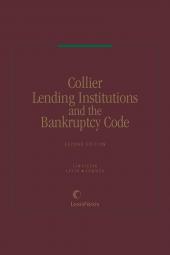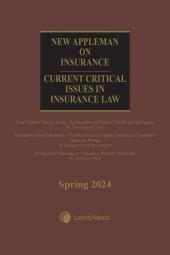Collier Lending Institutions and the Bankruptcy Code
Select subscription type
Terms & conditions
Subscribers receive the product(s) listed on the Order Form and any Updates made available during the annual subscription period. Shipping and handling fees are not included in the annual price.
Subscribers are advised of the number of Updates that were made to the particular publication the prior year. The number of Updates may vary due to developments in the law and other publishing issues, but subscribers may use this as a rough estimate of future shipments. Subscribers may call Customer Support at 800-833-9844 for additional information.
Subscribers may cancel this subscription by: calling Customer Support at 800-833-9844; emailing customer.support@lexisnexis.com; or returning the invoice marked "CANCEL".
If subscribers cancel within 30 days after the product is ordered or received and return the product at their expense, then they will receive a full credit of the price for the annual subscription.
If subscribers cancel between 31 and 60 days after the invoice date and return the product at their expense, then they will receive a 5/6th credit of the price for the annual subscription. No credit will be given for cancellations more than 60 days after the invoice date. To receive any credit, subscriber must return all product(s) shipped during the year at their expense within the applicable cancellation period listed above.
Subscribers receive the product(s) listed on the Order Form and any Updates made available during the annual subscription period. Shipping and handling fees are not included in the annual price.
Subscribers are advised of the number of Updates that were made to the particular publication the prior year. The number of Updates may vary due to developments in the law and other publishing issues, but subscribers may use this as a rough estimate of future shipments. Subscribers may call Customer Support at 800-833-9844 for additional information.
Subscribers may cancel this subscription by: calling Customer Support at 800-833-9844; emailing customer.support@lexisnexis.com; or returning the invoice marked 'CANCEL'.
If subscribers cancel within 30 days after the product is ordered or received and return the product at their expense, then they will receive a full credit of the price for the annual subscription.
If subscribers cancel between 31 and 60 days after the invoice date and return the product at their expense, then they will receive a 5/6th credit of the price for the annual subscription. No credit will be given for cancellations more than 60 days after the invoice date. To receive any credit, subscriber must return all product(s) shipped during the year at their expense within the applicable cancellation period listed above.
Product description
View a sample of this title using the ReadNow feature
The ultimate bankruptcy desk reference for lending institutions
Author James M. Lawniczak, along with Collier Editors-in-Chief Richard Levin and Henry J. Sommer, explore the critical challenges facing lending institutions, especially bank lending officers and in-house or outside counsel representing lending institutions before, during and after their borrowers file bankruptcy.
Collier Lending Institutions and the Bankruptcy Code has been substantially updated in the last three years and contains the important developments in bankruptcy law, including many very recent cases. It contains a step-by-step analysis of the bankruptcy process, from loan inception, loan administration and workouts all the way to a bankruptcy case.
The publication begins with a general overview of the Bankruptcy Code from the lender's perspective. It continues to discuss the bankruptcy issues a lending institution must consider at loan inception, including unsecured loans, secured loans, real estate loans, letters of credit, accounts receivable and inventory financing, derivative lending and securitization.
As borrowers show signs of financial distress, the book then leads you through amendment, waiver, composition and forbearance—through to a prepackaged bankruptcy plan, focusing on the tools the lending institution would use in this process. The chapters that follow then cover: the applicable law once your borrower files a bankruptcy case, including focus on debtor in possession financing; sales of assets, including all the assets of an entity; and Chapter 11 plans. The publication concludes with lender liability, providing a thorough understanding of the problems facing lending institutions.
The title addresses specific bankruptcy issues of which a lender must be aware, including:
• Bankruptcy considerations and strategies when structuring and documenting lending transactions
• Workouts and alternatives to bankruptcy
• Specific bankruptcy provisions affecting lenders, including automatic stay, executory contracts, preferences, setoff and fraudulent transfers
• Financing the debtor in possession
• Section 363 sales
• Chapter 11 plans of reorganization
• Lender liability
In addition, the publication contains many helpful checklists and forms that can assist lenders throughout the bankruptcy process, including: loan agreement forms; forms to be used in workouts, such as a forbearance agreement and a secured party section 9-610 sale; and forms used in bankruptcy, including forms related to use of cash collateral and debtor in possession financing, a bankruptcy sale order and a secured party proposed plan of reorganization.
eBooks, CDs, downloadable content, and software purchases are noncancelable, nonrefundable and nonreturnable. Click here for more information about LexisNexis eBooks. The eBook versions of this title may feature links to Lexis+® for further legal research options. A valid subscription to Lexis+® is required to access this content.
"Table of contents
Chapter 1: Overview of Provisions of the Bankruptcy Code Relating to Lending Transactions
1.01 Scope of This Chapter
1.02 Introduction to Bankruptcy
1.03 Sources of Bankruptcy Law
1.04 Bankruptcy Judges
1.05 Jurisdiction in Bankruptcy
1.06 Proper Venue for the Filing of a Petition
1.07 Eligibility for Relief
1.08 Commencement of a Voluntary Case
1.09 Commencement of an Involuntary Case
1.10 Conversion, Dismissal and Abstention
1.11 Property of the Estate
1.12 Postpetition Effect of Prepetition Security Interest
1.13 Creditors and Claims
1.14 The Parties to a Bankruptcy Proceeding
1.15 Fiduciary Duties of Insolvent Debtors and Their Directors and Professionals
1.16–1.50 [Reserved]
1.51 Checklist: Chapter 11 Creditor Checklist
1.52 Chart: Business Restructuring Activities and Scenarios
1.53 Summary: Basic Bankruptcy Jurisdiction
1.54 Checklist: Bankruptcy Code Priorities
1.55 Form: Default Letter with Reservation of Rights
1.56 Form: Waiver Agreement
Chapter 2: Bankruptcy Practice and the Lender
2.01 Scope of This Chapter
2.02 Lending Transactions
2.03 Bankruptcy Practice and Unsecured Lending Agreements
2.04 Bankruptcy Practice and Secured Lending Agreements
2.05 Bankruptcy Practice and Real Estate Financing
2.06 Letters of Credit
2.07 Accounts Receivable and Inventory Financing
2.08 Financing Through Derivatives—Safe Harbor Provisions
2.09 Securitization and Bankruptcy Remote Entities
2.10–2.50 [Reserved]
2.51 Form: Security Agreement
2.52 Form: Secured Promissory Note
2.53 Form: Payment Guarantee
Chapter 3: Business and Financial Alternatives to Bankruptcy
3.01 Scope of This Chapter
3.02 Restructuring Agreements and Other Arrangements Prior to Bankruptcy
3.03 Formal Alternatives to Bankruptcy
3.04 The Interplay Between Bankruptcy and Other Forms of Workout
3.05 The Prepackaged Chapter 11 Case
3.06–3.49 [Reserved]
3.50 Form: Creditor Composition Agreement
3.51 Form: Forbearance Agreement
3.52 Form: Reservation of Rights Letter
3.53 Form: Creditor Letter (No Proceeds Available)
3.54 Form: Creditor Letter (Proceeds Available)
Chapter 4: Impact of a Filing Under Title 11
4.01 Scope of This Chapter
4.02 Automatic Stay; 11 U.S.C. § 362
4.03 Executory Contracts and Unexpired Leases
4.04 Setoff and Recoupment
4.05 Preferences; 11 U.S.C. § 547
4.06 Fraudulent Conveyances
4.07 Trustee’s Other Avoiding Powers
4.08 Effect of a Bankruptcy Filing on Prepetition Security Interests; 11 U.S.C. § 552
4.09 Other Provisions Affecting Lender Rights
4.10–4.50 [Reserved]
4.51 Form: Notice of Motion for Relief from the Automatic Stay
4.52 Form: Memorandum of Law in Support of Motion for Relief from the Automatic Stay
4.53 Form: Affidavit in Support of Motion for Relief from the Automatic Stay
4.54 Form: Order Modifying Stay and Authorizing Obtaining of Credit (Setoff)
4.55 Form: Answer to Complaint to Recover Preference; Security Interest in Inventory and Receivables
4.56 Checklist and Worksheet; Avoiding Powers
Chapter 5: Financing the Debtor in Possession
5.01 Scope of This Chapter
5.02 Lending to a Debtor: An Overview
5.03 Goals of a Prepetition Lender to Be Accomplished by Financing a Debtor in Possession
5.04 Debtor in Possession Financing; Lending Under Section 364
5.05 Lending Under Section 363; Permission to Use Cash Collateral
5.06 Section 363 Lending v. Section 364 Lending; When One Is More Advantageous Than the Other
5.07 Lending in Involuntary Cases Before the Order for Relief
5.08 Payment of Administrative Expenses; § 503(a)
5.10–5.50 [Reserved]
5.51 Form: Order Authorizing Incurrence of Unsecured Debt and Assumption of Agreement
5.52 Form: Order to Show Cause Authorizing Borrowing Under Section 364(c)(1) and (2)
5.53 Form: Financing Order; § 364(c) & (d)(1)
5.54 Form: Secured Creditor Consent to Use of Cash Collateral
5.55 Form: Secured Creditor Notice of Cash Collateral Prohibition (“Do Not Use Cash Collateral Letter”)
5.56 Form: Motion for Order Segregating Cash Collateral and Granting Adequate Protection
5.57 Form: Order Directing Segregation of Cash Collateral and Granting Adequate Protection
5.58 Form: Interim Financing Order; § 364(c); Cross-Collateralization
5.59 Form: Order Continuing Financing Order
Chapter 6: Sales, Including Sales of a Business Under Section 363
6.01 Scope of This Chapter
6.02 Introduction to Section 363 and Sales
6.03 Sale of Property in the Ordinary Course of Business
6.04 Sale of Individual Property Outside the Ordinary Course of Business
6.05 Sales of the Entire Business
6.06 Closing the Sale
6.07 Tax Considerations
Chapter 7: Chapter 11 Plans of Reorganization
7.01 Scope of This Chapter
7.02 Getting to Confirmation
7.03 Filing a Plan; § 1121
7.04 Contents of a Plan; § 1123
7.05 Classification of Claims and Interests in the Plan; § 1122
7.06 Treatment of Claims and Interests Under the Plan; §§ 1111 and 1124
7.07 Acceptance Process
7.08 Confirmation
7.09 Effect of Confirmation
7.10 Securities and Tax Law Issues Relating to Confirmed Plan
7.11–7.50 [Reserved]
7.51 Checklist: Disclosure Statements
7.52 Form: Plan of Reorganization Proposed by Secured Creditor
7.53 Form: Order Confirming Plan
Chapter 8: Lender Liability
8.01 Scope of This Chapter
8.02 General Advice for Lenders
8.03 Liability Arising from Loan Origination Activities
8.04 Liability Arising from Administration of the Loan
8.05 Liability Arising from Relations with Third Parties
8.06 Bankruptcy and Other Insolvency Problems
8.07–8.50 [Reserved]
8.51 Form: Commitment Letter (Including Term Sheet and Fee Letter) for Secured Acquisition Facilities
8.52 Form: Language to Be Used with Proposal Letter
8.53 Form: Confidentiality Agreement
8.54 Form: Confidentiality Provision
8.55 Form: Environmental Provisions
 Lexis Nexis
Lexis Nexis 


